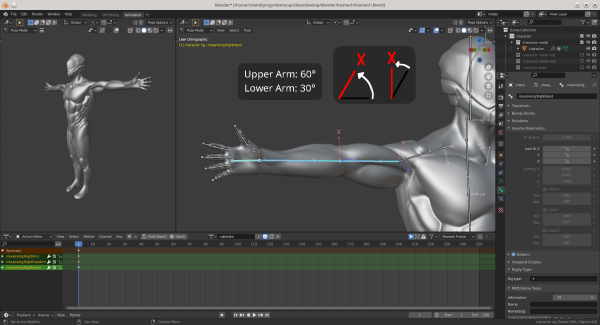This is an old revision of the document!
Table of Contents
Start Page » DEMoCap: Drag[en]gine Motion Capture » Prepare Character for Motion Capture (Blender3D)
Prepare Character for Motion Capture (Blender3D)
The first step for doing successful motion capture with DEMoCap is to prepare your character model in Blender3D or any other 3D application able to export into a 3D format supported by Drag[en]gine.
DEMoCap does not alter the armature/skeleton used for your character. To do this though it requires you to create a few animations each consisting of single animation frame. This page outlines the used animations and how to create them. You can name the animations whatever you like. Export all animations into a single animation file. You can then assign this animation file in the Edit Character dialog.
Calibration Pose
The calibration pose has to match as closely as possible the T-Pose stroke by the motion capture actor during calibrating. Many characters are designed by artists in a T-Pose or A-Pose. In this description we assume a T-Pose character as base character.
Arms and legs have to be placed at 90 degrees and thus point straight to the side respectively to the ground. They have to be straight not bend.
T-Pose characters are typically designed with the palms facing downwards. Motion capture actors though calibrate with palms facing forward. In this pose the arms are rotated differently than T-Pose characters typically have. Rotate the upper arm to face 60 degrees upwards and the lower arm to face an additional 30 degrees upwards. The palms should now face forward as if the character is about to grab a VR controller.
Fingers have to be straight not bend. The amount of splay between the fingers is not important.
Knees and feet have to face forward. Feet can optionally be rotated along the Y axis but it is recommended to align forward for easier calibration.
Spine has to be straight upwards. The head should be above the waist and feet. In general make the character stand straight upright. If the character is hunched over this can be done using motion transfers later on dynamically.
Base Inverse Kinematics (IK) Pose
The most important motion transfer used for motion capture is the Inverse Kinematics (IK) motion transfer. IK in general has troubles to calculate good poses if the limbs start out in straight pose as done in the calibration pose above. It is thus highly recommended to create a base pose to use before applying inverse kinematics to get the best result.
The image above shows how the actor should best look like.
Arms and legs should be lightly bend. For the knees angles of 10-20 degrees are fine. For elbows 45 degrees are recommended.
The tutorial video below shows how to best achieve the arm pose.




